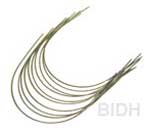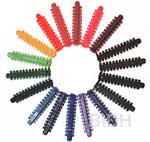Conventional Orthodontic Treatment with Metal Braces
The most common type of braces are traditional metal braces. Traditional braces mainly consist of a small bracket glued to the front part of each tooth. In certain cases, a band used in the molars to provide support. The brackets may be decorated with different o-rings, so individuals are able to choose their favorite color and create their own unique style.
Traditional braces are composed of different orthodontic components:

Brackets
Brackets are small devices that are bonded (glued) to the surfaces of teeth. Traditional brackets are made of metal. Current orthodontic innovations now include clear brackets. Brackets provide a strong attachment to the tooth which allows the forces of the arch wire to be transmitted to the teeth.

Archwires
Archwires are the main wire that connects all the brackets together on the outside of the teeth. It provides force to move the teeth. Archwires act as a guide or track along which the teeth move. Arch wires are normally changed numereous times during the course of the orthodontic treatment.

O-Rings
O-rings are little elastic rings, also called A-lastics, that are used to attach the arch wire to the brackets. These rings come in standard gray or clear, but also come in a wide variety of colors to make braces more fun. A-lastics are changed at every appointment to maintain good attachment of the arch wire to the bracket. Patients are able to choose and enjoy many different color schemes throughout treatment.

Hooks
Hooks are small, blunt attachments to the brackets that allow the patient to wear elastics from the top to the bottom teeth.

Elastics
Elastics are rubber bands used to provide added pressure to help move the teeth and jaws into better alignment. The patient wears elastics as indicated. With today's advancements in orthodontic materials and techniques, elastics are no less commonly used.










